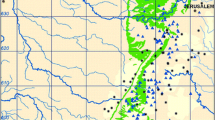Abstract
Spatial factor analysis (SFA) is a multivariate method that determines linear combinations of variables with maximum autocorrelation at a given lag. This is achieved by deriving estimates of auto-/cross-correlations of the variables and calculating the corresponding eigenvectors of the covariance quotient matrix. A two-point spatial factor analysis model derives factors by the formation of transition matrixU comparing auto-/cross-correlations at lag “0,”R 0, with those at a specified lag “d,”R d, expressed asU d=R −10 Rd. The matrixU d can be decomposed into its spectral components which represent the spatial factors. The technique has been extended to include three points of reference. Spatial factors can be derived from the relationship:
where the factors ofU d1 andU d2 predict the relationships of the variables over three lag distances and orientations from matricesR d1,R d2, andR d3. Estimates of auto-/cross-correlation can be achieved using irregularly spaced or gridded data from experimental correlograms or function estimates determined from the experimental correlograms. The technique has applications in studies where several variables have different spatial ranges or zones of influence.
Similar content being viewed by others
References
Agterberg, F. P., 1966, The Use of Multivariate Markov Schemes in Petrology: J. Geol., v. 79, p. 764–785.
Agterberg, F. P., 1970, Autocorrelation Functions in Geology,in D. F. Merriam (Ed.), Geostatistics: Plenum, New York, p. 113–142.
Agterberg, F. P., 1974, Geomathematics: Elsevier, Amsterdam, 596 p.
Aitchison, J., 1986, The Statistical Analysis of Compositional Data: Chapman and Hall, New York, 416 p.
Chung, C. F., and Fabbri, A. G., in press, Two Approaches to Parsimony of Multi-channel Remote Sensed Data,in G. Hill (Ed.), Advanced Data Integration in Mineral and Energy Resources Studies: USGS Bulletin.
Colvine, A. C., et al., 1988, Archean Lode Gold Deposits in Ontario: Ontario Geological Survey, Miscellaneous Paper 139, 136 p.
Grunsky, E. C., 1986, Recognition of Alteration in Volcanic Rocks Using Statistical Analysis of Lithogeochemical Data: J. Geochem. Expl., v. 25, p. 157–183.
Grunsky, E. C., 1988, Multivariate and Spatial Analysis of Lithogeochemical Data from Metavolcanics with Zones of Alteration and Mineralization in Ben Nevis Township, Ontario: Unpublished Ph.D. thesis, University of Ottawa.
Grunsky, E. C., 1989, Spatial Factor Analysis: A Technique to Assess the Spatial Relationships of Multivariate Data,in F. P. Agterberg and G. F. Bonham-Carter (Eds.), Statistical Applications in the Earth Sciences: Geological Survey of Canada Paper 89–9, p. 329–347.
Grunsky, E. C., and Agterberg, F. P., 1988, Spatial and Multivariate Analysis of Geochemical Data from Metavolcanic Rocks in the Ben Nevis Area, Ontario: Math. Geol., v. 20, n. 7, p. 825–861.
Grunsky, E. C., and Agterberg, F. P., 1989, The Application of Spatial Factor Analysis to Unconditional Simulations with Implications for Mineral Exploration,in Applications of Computers and Operations Research in the Mineral Industry (APCOM), Chap. 20: 1989 Proceedings, p. 194–208.
Grunsky, E. C., and Agterberg, F. P., 1991a, FUNCORR: A FORTRAN 77 Program for Computing Multivariate Spatial Autocorrelation: Comput. Geosci., v. 17, n. 1, p. 115–131.
Grunsky, E. C., and Agterberg, F. P., 1991b, SPFAC: A Fortran 77 Program for Spatial Multivariate Analysis: Comput. Geosci., v. 17, n. 1, p. 133–160.
Haining, R., 1987, Trend Surface Models with Regional and Local Scales of Variation with an Application to Aerial Survey Data: Technometrics, v. 29, n. 4, p. 461–469.
Journel, A. G., and Huijbregts, C. J., 1978, Mining Geostatistics: Academic Press, London, 6 p.
LeMaitre, R. W., 1982, Numerical Petrology, Statistical Interpretation of Geochemical Data: Elsevier, New York, 281 p.
Myers, D. E., 1982, Matrix Formulation of Co-kriging: Math. Geol., v. 14, p. 249–257.
Myers, D. E., 1988, Some New Aspects of Multivariate Analysis,in A. G. Fabbri, C. F. Chung, and R. Sinding-Larsen (Eds.), Statistical Treatments for Estimation of Mineral and Energy Resources; Proc. NATO Conference Held at Il Ciocco, Italy, July 1986, Reidel, Dordrecht, p. 669–687.
Pawlowsky, V., 1989, Co-kriging of Regionalized Compositions: Math. Geol., v. 21, p. 512–521.
Press, W. H., Flannery, B. P., Teukolsky, S. A., and Vetterling, W. T., 1986, Numerical Recipes, The Art of Scientific Computing: Cambridge University Press, 818 p.
Quenouille, M. H., 1957, The Analysis of Multiple Time-Series: Hafner, New York, 105 p.
Royer, J.-J., 1988, Geochemical Data Analysis,in A. G. Fabbri, C. F. Chung, and R. Sinding-Larsen (Eds.), Statistical Treatments for Estimation of Mineral and Energy Resources: Proc. NATO Conference Held at Il Ciocco, Italy, July 1986, Reidel, Dordrecht, p. 89–112.
Shepard, D., 1968, A Two-Dimensional Interpolation Function for Irregularly Spaced Data: Proceedings of the 23rd National Conference, Association for Computing Machinery, Brandon, Princeton, N.J., p. 517–524.
Switzer, P., and Green, A. A., 1984, Min/Max Autocorrelation Factors for Multivariate Spatial Imagery: Tech. Report No. 6, April 1984, Department of Statistics, Standard University, 14 p.
Wackernagel, H., 1988, Geostatistical Techniques for Interpreting Multivariate Spatial Information,in A. G. Fabbri, C. F. Chung, and R. Sinding-Larsen (eds.), Statistical Treatment for Estimation of Mineral and Energy Resources: Proc. NATO Conference Held at Il Ciocco, Italy, July 1986, Reidel, Dordrecht, p. 393–349.
Author information
Authors and Affiliations
Rights and permissions
About this article
Cite this article
Grunsky, E.C., Agterberg, F.P. Spatial relationships of multivariate data. Math Geol 24, 731–758 (1992). https://doi.org/10.1007/BF00894238
Received:
Accepted:
Issue Date:
DOI: https://doi.org/10.1007/BF00894238




